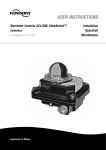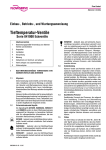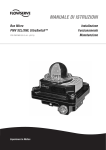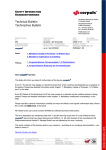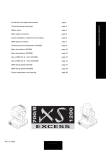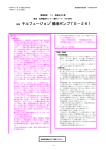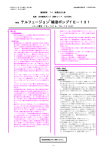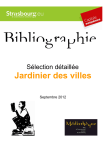Download Airfree FIT 700 Specifications
Transcript
PT 700 Electro-Pneumatic Transducer Installation Operation Maintenance 2 Contents 1. General information ........................................................................................ 3 1.1 Using ................................................................................................................................. 3 1.2 Terms concerning safety ................................................................................................... 3 1.3 Protective clothing ............................................................................................................. 3 1.4 Qualified personnel ........................................................................................................... 3 1.5 Installation ......................................................................................................................... 3 1.6 Spare parts ........................................................................................................................ 4 1.7 Service / repair .................................................................................................................. 4 1.8 Storage .............................................................................................................................. 4 1.9 Valve and actuator variations ............................................................................................ 4 2. Unpacking ........................................................................................................ 4 3. PT 700 overview .............................................................................................. 5 4. Specifications .................................................................................................. 5 5. Principle of operation ..................................................................................... 6 6. Mounting and installation ............................................................................... 6 6.1 General ............................................................................................................................. 6 6.2 Mounting of the PT 700 Positioner on a Linear Pneumatic Actuator (NAMUR / IEC 534 part 6) ...................................................................................................... 7 6.3 Rotary actuators ................................................................................................................ 8 7. Tubing PT 700 to actuator .............................................................................. 9 8. Wiring and grounding guidelines ................................................................ 10 8.1 Grounding screw ............................................................................................................. 10 8.2 Electromagnetic compatibility .......................................................................................... 10 9. Start-up ...........................................................................................................11 9.1 Adjusting the potentiometers ............................................................................................11 9.2 DIP switch configuration 10. Trouble shooting .......................................................................................... 12 11. PT 700 transducer model code ................................................................... 12 12. Spare pars ..................................................................................................... 13 3 1. General information 1.1 Using The following instructions are designed to assist in unpacking, installing and performing maintenance as required on FLOWSERVE products. Product users and maintenance personnel should thoroughly review this bulletin prior to installing, operating or performing any maintenance. In most cases FLOWSERVE valves, actuators and accessories are designed for specific applications (e.g. with regard to medium, pressure, temperature). For this reason they should not be used in other applications without first contacting the manufacturer. 1.2 Terms concerning safety The safety terms DANGER, WARNING, CAUTION and NOTE are used in these instructions to highlight particular dangers and/or to provide additional information on aspects that may not be readily apparent. DANGER: indicates that death, severe personal injury and/or substantial property damage will occur if proper precautions are not taken. WARNING: indicates that death, severe personal injury and/or substantial property damage can occur if proper precautions are not taken. CAUTION: indicates that minor personal injury and/ or property damage can occur if proper precautions are not taken. NOTE: indicates and provides additional technical information, which may not be very obvious even to qualified personnel. Compliance with other, not particularly emphasised notes, with regard to transport, assembly, operationand maintenance and with regard to technical documentation (e.g. in the operating instruction, product documentation or on the product itself) is essential, in order to avoid faults, which in themselves might directly or indirectly cause severe personal injury or property damage. 1.3 Protective clothing FLOWSERVE products are often used in problematic applications (e.g. extremely high pressures, dangerous, toxic or corrosive mediums). In particular valves with bellows seals point to such applications. When performing service, inspection or repair operations always ensure, that the valve and actuator are depressurised and that the valve has been cleaned and is free from harmful substances. In such cases pay particular attention to personal protection (protective clothing, gloves, glasses etc.). 1.4 Qualified personnel Qualified personnel are people who, on account of their training, experience and instruction and their knowledge of relevant standards, specifications, accident prevention regulations and operating conditions, have been authorised by those responsible for the safety of the plant to perform the necessary work and who can recognise and avoid possible dangers. 1.5 Installation DANGER: Before installation check the order-no, serial-no. and/or the tag-no. to ensure that the valve/actuator is correct for the intended application. Do not insulate extensions that are provided for hot or cold services. Pipelines must be correctly aligned to ensure that the valve is not fitted under tension. Fire protection must be provided by the user. 4 1.6 Spare parts 1.8 Storage Use only FLOWSERVE original spare parts. FLOWSERVE cannot accept responsibility for any damages that occur from using spare parts or fastening materials from other manufactures. If FLOWSERVE products (especially sealing materials) have been on store for longer periods check these for corrosion or deterioration before using these products. Fire protection for FLOWSERVE products must be provided by the end user. In most cases FLOWSERVE products are manufactured from stainless steel. Products not manufactured from stainless steel are provided with an epoxy resin coating. This means that FLOWSERVE products are well protected from corrosion. Nevertheless FLOWSERVE products must be stored adequately in a clean, dry environment. Plastic caps are fitted to protect the flange faces to prevent the ingress of foreign materials. These caps should not be removed until the valve is actually mounted into the system. 1.7 Service / repair To avoid possible injury to personnel or damage to products, safety terms must be strictly adhered to. Modifying this product, substituting nonfactory parts, or using maintenance procedures other than outlined in this instruction could drastically affect performance and be hazardous to personnel and equipment, and may void existing warranties. Between actuator and valve there are moving parts. To avoid injury FLOWSERVE provides pinch-point-protection in the form of cover plates, especially where side-mounted positioners are fitted. If these plates are removed for inspection, service or repair special attention is required. After completing work the cover plates must be refitted. Apart from the operating instructions and the obligatory accident prevention directives valid in the country of use, all recognised regulations for safety and good engineering practices must be followed. WARNING: Before products are returned to FLOWSERVE for repair or service FLOWSERVE must be provided with a certificate which confirms that the product has been decontaminated and is clean. FLOWSERVE will not accept deliveries if a certificate has not been provided (a form can be obtained from FLOWSERVE). 1.9 Valve and actuator variations These instructions cannot claim to cover all details of all possible product variations, nor in particular can they provide information for every possible example of installation, operation or maintenance. This means that the instructions normally include only the directions to be followed by qualified personal where the product is being used for it´s defined purpose. If there are any uncertainties in this respect particularly in the event of missing product-related information, clarification must be obtained via the appropriate FLOWSERVE sales office. 2. Unpacking Each delivery includes a packing slip. When unpacking, check all delivered valves and accessories using this packing slip. Report transport damage to the carrier immediately. In case of discrepancies, contact your nearest FLOWSERVE location. 5 3. PT 700 Electro-Pneumatic Transducer The electro-pneumatic transducer PT 700 series provides the proportional conversion from a 4...20 mA input signal to a 0...100% supply pressure output signal. This device provides the interface between the electro-pneumatic positioner and a pneumatic actuator of process industrial applications (chemical, petro-chemical, refineries etc.). They are easy to adapt and improve the performance of the control loop with optimized dynamic behaviour. The transducer PT 700 series is the first which uses piezoelectric microvalves with low power consumption allowing connection to standard two-wire circuits. No extra power supply is needed and makes the device very compact and robust. 4. Specifications Input signal Input signal range Input signal range for split range application Equivalent electrical load Voltage supply min. Voltage supply max. Current supply min. Current supply max. Auxiliary power Media characteristics Oil contents Dust particles Input pressure range Air consumption Supply air influence Output signal Output pressure range Output volume 4 — 20 mA 4 — 12 or 12 — 20 mA 300 Ω max. at 20 mA input current 6 VDC 9,5 VDC 3,6 mA 100 mA Pressurized air or allowed gas, free of oil and dust according to IEC 770 ≤ 1 ppm ≤ 3 µm 1,5 — 6,0 bar 0,08 m3/h at 1,5 bar input pressure 0,12 m3/h at 6,0 bar input pressure < 0,1 % per 1,0 bar supply air pressure 0 — 100 % of supply air pressure 2,4 m3/h at 1,5 bar input pressure 7,0 m3/h at 6,0 bar input pressure Features • Accurate conversion of the electrical input signal by using a silicon pressure sensor for feedback. • Robust modular design • Pressure regulator eliminates variations in supply air pressure. • Innovative, reliable transducer technology (piezo electric microvalve) • Input signal: 4 — 20mA • Split range start 4 mA or 12 mA • High resistance against shock and vibration • Two wire system for signal and power supply line • Easy maintenance due to modular design • Universal mounting kit according to NAMUR specifications in stainless steel • Precise control performance and high dynamic behaviour with PI control characteristics in the internal control loop behaviour with PI control characteristics in the internal control loop Control characteristics (typical) Linearity deviation < 1,0 % Hysteresis < 0,5 % Input sensitivity < 0,05 % Repeatability < 0,1 % Start-up drift < 0,5 % Cut-off frequency > 1,3 Hz at 1 dm3 Vibration sensitivity < 1 % at 1 and 2g (3 — 300 Hz) acc. to IEC 61514 Ambient temperature sensitivity < 0,5 % / 10K Operating temperature –20 °C — +85 °C (option: –40°C — +85°C) Transport and storage temperature –40°C — +85°C Operating humidity 5 — 95 % rh Protection standard IP 66, Nema 4x Declaration of conformity Mounting position sensitivity Physical Specifications Housing Material Soft Goods Weight Complies with 89/336 EEC < 0,25 % Cast aluminum, powder-painted Nitrile 1,2 kg (2,7 lbs) 6 FILTER/REGULATOR FOR SUPPLY AIR PRESSURE REGULATOR 1.5 ... 6.0 bar LFR 43164001 GAIN k > 50 DAMP Pk Signal (W) 1,5 ... 4 bar 0...4 bar 4 ... 20mA SPAN ZERO PIEZOELEMENT SIGNAL AMPLIFIER PNEUM. AMPLIFIER ELECTRO-PNEUMATIC CONVERTER CONTROLLER ELECTRONIC CONTROL UNIT E mV P PRESSURE SENSOR Figure 1. 5. Principle of operation The PT 700 positioner is an analog positioner with various options. The positioner consists of three main modules: 1. The electronic control module including direct local user interface switches 2. The piezo valve-based electro-pneumatic converter module 3. The infinite resolution valve position sensor. The basic positioner operation is best understood by referring to figure 1. The complete control circuit is powered by the two-wire, 4-20 mA command signal. The analog 4-20 mA command is passed to the electronic, where it is compared to the measured valve stem position. The control algorithm performs control calculations and produces an output command to the piezo valve, which drives the pneumatic amplifier. The position of the pilot valve in the pneumatic amplifier is measured and relayed to the inner loop control circuit. This two-stage control provides for more responsive and tighter control than is possible with a single stage control algorithm. The pneumatic amplifier controls the airflow to the actuator. The change of pressure and volume of the air in the actuator causes the valve to stroke. As the valve approaches the desired position, the difference between the commanded pressure and the measured pressure becomes smaller and the output to the piezo is decreased. This, in turn, causes the pilot valve to close and the resulting flow to decrease, which slows the actuator movement as it approaches, the new commanded position. When the valve actuator is at the desired position. the pneumatic amplifier output is held at zero, which holds the valve in a constant position. 6. Mounting and installation 6.1 General Before starting installation, inspect the digital positioner for any transport damages. The PT 700 is installed with a mounting kit (according to NAMUR specification) to the left-hand actuator support rod. Generally, the unit can be installed in any mounting position. The mounting of rod actuators (according to NAMUR) is described in Figure 3. For the two mounting possibilities of cast yoke actuators (according to NAMUR, lEC 534 part 6) refer to Figure 6 and 7. After installation, ensure that all screw connections are tightened correctly and all moving parts are free from excessive friction. 7 Figure 2. Dimensional drawing 6.2 Mounting of the PT 700 on a linear pneumatic actuator (NAMUR / IEC 534 part 6) (See Figure 3) The mounting of a rod actuator kit (according to IEC 534 part 6) is described in an example by using the following equipment: Valve: Standard globe valve or equivalent Actuator: Single-acting pneumatic actuator Positioner: PT 700 Series with NAMUR mounting kit Pre-assembly: Valve with actuator (valve stroke is matched with the actuator stroke). Figure 3. Mounting on a Rod Actuator For mounting, proceed as follows: Mounting the positioner 1. Attach the PT 700 to the pre-assembled mounting bracket and fasten it with two hexagon head screws and two lock washers. Mounting A Mounting B Hexagon head screw 2. Pre-assemble the mounting bracket on the left actuator leg hand-tight with two U-bolts, nuts and lockwashers. 3. Tighten all screws and nuts. Lock washer Figure 4. Yoke Actuator Mounting (according to IEC 534 part 6) 8 6.3 Rotary actuators Mounting the PT 700 on a quarter-turn actuator (closed or open by spring) The mounting of a pneumatic double-piston quarter-turn valve actuator (in accordance with VDI/VDE 3845) is described as an example by using the following equipment: 4 1 Quarter-turn valve actuator: Rack & pinion or scotch yoke, closed or opened by spring. 3 2 Figure 5. Linear actuator “FlowAct” (Direct mounting, integrated tubing. 1 Check O-rings, Install bracket 1 to positioner and secure with screws. 2 Fit and check O-rings and positioner to actuator and secure with 2 x screws 2. No tubing needed, it’s integrated with actuator, fit plug in PT 700 out port. Figure 6. 3 Linear actuator VDI/VDE 3847 (Direct mounting, integrated tubing. 2 Check O-rings, Install bracket 1 to positioner and secure with 2 x screws 2. Fit and check O-rings and positioner to actuator and secure with 2 x screws 3. 1 No tubing needed, it’s integrated with actuator. Figure 7. 9 7. Tubing PT 700 to actuator After mounting has been completed, the stationary pipework can be made with suitable pipe connections, e.g. Ermeto-Connections or other cutting ring connections: Air connections: Auxiliary power: Pressure range: 1/4’’—18 NPT (standard air connection) pressurized air or allowed gas, (supply air) free of oil and dust according to IEC 770 1,5 — 6,0 bar To connect the air piping, the following notes should be observed: Air requirements Maximum supply presure is 6 bar. Supply air should be clean, dry and free from oli, water, moisture, foreign parts and debris. The air shall be freeze-dried or similar to a dew point of at least 10°C (18°F) below lowest expected ambient temperature. A <5 µm filter/regulator is recommended to be installed as close to PT 700 as possible to ensure proper supply air quality. Before making pneumatic connections to the PT 700, it is recommended that the supply air lines are opened up and allowed to vent for 2-3 minutes to clear any debris from the line. It is further recommended that a large paper bag is used to collect any oil or humidity that may be present in the line during this purging, direct the air flow into this bag. Should traces of oil and/or humidity be present at this stage, a review of the pneumatic system should be carried out and the problem corrected. Poor air quality is one of the major causes of premature failure of pneumatic equipment • With an operating pressure of more than 4 bar, a reducing regulator is required. The air supply of the reducing regulator must be larger than the air consumption of the transducer. • The actuator must always be connected to the outlet connector of the transducer. For transducers with pressure gauge, first attach the gauge block. 10 Connection + – Description Input +4 - 20 mA Input –4 - 20 mA Pneumatic output signal (outlet) Grounding screws I tsignal i l Input (Shielded cable) Air supply Figure 8. Connections 8. Wiring and grounding guidelines Electrical connections: signal cable with cable passage NPT, or M20 x 1,5) to terminals 2 x 2,5 mm Input signal: 4 – 20 mA • Observe the minimum requirements of voltage and equivalent electrical load: PT 700 6 VDC / 300 Ω at 20 mA • The performance is ensured only for a minimum input current of 3,6 mA. For wiring, the following notes should be observed: 8.2 Electromagnetic compatibility The PT 700 Electro-Pneumatic Transducer has been designed to operate correctly in electromagnetic (EM) fields found in typical industrial environments. Care should be taken to prevent the positioner from being used in environments with excessively high EM field strengths (greater than 10 V/m). Portable EM devices such as handheld two-way radios should not be used within 30 cm of the device. Ensure proper wiring and shielding techniques of the control lines, and route control lines away from electromagnetic sources that may cause unwanted noise. • Absolutely observe the note CAUTION on page 3. An electromagnetic line filter can be used to further eliminate noise. 8.1 Grounding screw In the event of a severe electrostatic discharge near the positioner, the device should be inspected to ensure correct operability. It may be necessary to recalibrate the PT 700 positioner to restore operation. The equipment must be grounded in accordance with the regulations. This ground should be tied to the same ground as the electrical conduit. For potential compensation via ring circuit, connect a second ground cable to the additional terminal provided outside. Additionally, the electrical conduit should be earth grounded at both ends of its run. The grounded screw must not be used to terminate signal shield wires. 11 9. Start-up Cut off 20 mA Cut off 4 mA DIP switches 1–6 4 – 20 mA input Gain tuning Damp tuning Span adjustment Zero adjustment Figure 9. Local interface For start-up and adjustment unscrew the cover of the transducer. The transducer cover contains a short description of the adjustment. DAMP-potentiometer (dampadjustment) Potentiometer for adjusting the damping. 9.1 Adjustment of the potentiometers ZERO-potentiometer (startpoint adjustment) The startpoint can be adjusted with ZEROpotentiometer by using a screwdriver. GAIN-potentiometer (gain adjustment) The gain of the transducer is factory set to K = 50. the Clockwise turns increase the output presssure and counter- clockwise turns decrease it. The adjusted value can be influenced by the range adjustment. A check of the adjustment is necessary. SPAN-potentiometer (range adjustment) The end position can be adjusted with the SPAN potentiometer by using a screwdriver. Clockwise turns increase the output presssure, counter clockwise turns decrease it. The adjusted value can be influenced by the startpoint adjustment. A check of the adjustment is necessary. Cut off 4 mA Setting the cut off for 4 mA. Cut off 20 mA Setting the cut off for 20 mA. 9.2 DIP switch configuration Default setting: off on • 1. Split range (Default off) • 2. 20 - 4 (Default off) • 3. 4 - 20 (Default on) • 4. Cut off 20 (Default off) • 5. Cut off 4 (Default off) • 6. Dir/rev (Default off) 12 10. Trouble shooting PT 700 symptoms and solutions Fault symptom Action The transducer is not stable. It is oscillating around the desired output pressure. The factory set of the gain is optimal for the most applications. In some applications however, there can be an oscillation, which can be eliminated by reducing the flow rate. Another way of eliminating the oscillations is to adjust the gain and damp parameters. If the connected volume at the outlet (Y) is less than 1000 cm3 an oscillation can appear. Turning the installed throttle valve at the reverse side of the device can stabilize the operation. The transducer uses the input signal to supply the electronics. The transducer does not operate. A minimum input current of 3,5 mA is required to operate the device. The minimum input voltage must be 6 VDC / 300 Ω. The transducer does not reach the end position. The equivalent electrical load of the transducer is max. 300 Ω. A process control system that supplies at least 6 Volt/20 mA should be used. 11. PT 700 transducer model code Base Transducer Model PT 7 0 0 - A B C - D A= Housing W Flowserve: Aluminum, Black w/ white cover, no window Y Flowserve: Aluminum, Black w/ yellow cover, no window B Flowserve: Aluminum, Black w/ black cover, no window B= Threaded connections 1 1/2 NPT conduit, 1/4 NPT pneumatic 2 M20 x 1,5 conduit, 1/4 NPT pneumatic C= Operating temperature S Standard -20°C to 85°C (-4°F to 176°F) E Extended -40°C to 85°C (-40°F to 176°F) D= Gauge options 0 No gauges 1 Output, PSI/BAR/KPA Stainless with brass internals 2 Output + Supply, PSI/BAR/KPA Stainless with brass internals 3 Output, PSI/BAR/KPA Stainless with stainless internals 4 Output + Supply, PSI/BAR/KPA Stainless with stainless internals Mounting options A Flowact Direct mounting B VDI/VDE 3847 Direct mounting C IEC 534-6 Namur linear mounting D Wall / 2" pipe mounting bracket p/n 30144 30145 30168S D3R-AS6 13 12. Spare parts 5 3 6 8 2 4 7 10 9 Pos. 1 2 3 3 4 4 5 5 6 7 8 8 8 8 8 8 8 8 8 8 9 10 1 PMV P/N Description Remarks N/A D2-SP50 STD D2-SP50 LT 7-SP82 7-SP82-I 7-SP25W 7-SP25B ?? 30737 ?? ?? 30135 ?? D2-SP40GB0 D2-SP40GC0 D2-SP40GB1 D2-SP40GC1 D2-SP40GB2 D2-SP40GC2 D2-SP40GB3 D2-SP40GC3 D2-SP40GB4 D2-SP40GC4 30144 30145 Housing Presure sensor assembly Air relay assy. incl. O-rings, screws, standard temp. Air relay assy. incl. O-rings, screws, low temp. Electronic module, PCB PT 700 Electronic module, PCB, Intrinsically safe PT 715 Front cover, no indicator, white, incl. screws Front cover, no indicator, black, incl. screws Seal and O-ring kit Screw and washer kit Gauge block B 1/4"NPT, 1/4"NPT, 1/8"NPT, no gauges Gauge block C 1/4"NPT, 1/4"NPT, 1/8"G, no gauges Gauge block B 1/4"NPT, 1/4"NPT, 1/8"NPT, 1 gauge (SS/brass) Gauge block C 1/4"NPT, 1/4"NPT, 1/8"G, 1 gauge (SS/brass) Gauge block B 1/4"NPT, 1/4"NPT, 1/8"NPT, 2 gauges (SS/brass) Gauge block C 1/4"NPT, 1/4"NPT, 1/8"G, 2 gauges (SS/brass) Gauge block B 1/4"NPT, 1/4"NPT, 1/8"NPT, 1 gauge (SS/SS) Gauge block C 1/4"NPT, 1/4"NPT, 1/8"G, 1 gauge (SS/SS) Gauge block B 1/4"NPT, 1/4"NPT, 1/8"NPT, 2 gauges (SS/SS) Gauge block C 1/4"NPT, 1/4"NPT, 1/8"G, 2 gauges (SS/SS) FlowAct mounting kit incl. O-rings, screws VDI/VDE 3847 mounting assy. incl. O-rings, screws EEx ia Palmstierna International AB Korta Gatan 9 SE-171 54 Solna SWEDEN Tel:+46 (0) 8 555 106 00 Fax: +46 (0) 8 555 106 01 E-mail: [email protected] Internet: www.flowserve.com Flowserve Van Leeuvenhoekweg 6 3225 LX Hellevoetsluis THE NETHERLANDS Tel: +31 (0) 181330044 Fax: +31 (0) 181330040 Flowserve Kassernengasse 6 9500 Villach AUSTRIA Tel: +43 (0) 424241 181-0 Fax: +43 (0) 424241 181 50/ 51 Flowserve Via Prealpi, 30 Cormano (Milano) ITALY Tel: +39 (0) 2663251 Fax: +39 (0) 26151863 Flowserve Av. Dr. Antunes Guimaraes 1159 Porto 4100-082 PORTUGAL Tel: +351 22 619 8770 Fax: +351 22 619 7575 Flowserve 1350 N. Mt. Springs Prkwy. Springville, UT 84663 USA Tel: +1 801 489 8611 Fax: +1 801 489 3719 Flowserve Post box 9279 Edenglen 1613 SOUTH AFRICA Tel: +27 11 923 7300 Fax: +27 11 974 6127 Flowserve 12 Tuas Avenue 20 REPUBLIC OF SINGAPORE 638824 Tel: +65 862 3332 Fax: +65 862 4940 Flowserve C/O Saleh & Abdulaziz Abahsain P.O. Box 209 Al Khobar 31952 SAUDI ARABIA Tel: 9663 857 3442 Fax: 9663 859 5284 PMV p/n: 31857 07/01 Flowserve 12, av. du Québec 91965 Courtaboeuf Cedex FRANCE Tel: +33 (0) 1 60 923 251 Fax: +33 (0) 1 60 923 299 Flowserve Allee du Quartz 1 CH-2300 La-Chaux-de Fonds SWITZERLAND Tel: +41 (0) 32 925 9700 Fax: +41 (0) 32 926 5422 DS-konsult Flowserve Manderscheidtstrasse 19 45141 Essen GERMANY Tel: +49 (0) 201 8919 5 Fax: +49 (0) 201 8919 662














